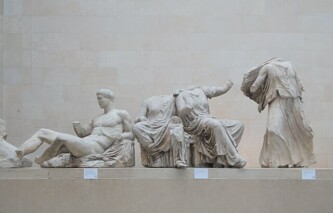Greek Prime Minister Kyriakos Mitsotakis has once again called for the return of the Elgin Marbles, also known as the Parthenon Sculptures, from the British Museum in London. Mitsotakis compared the situation to cutting the Mona Lisa in half, emphasizing the importance of reuniting the ancient Greek treasures. The Elgin Marbles were brought to the UK by British diplomat Lord Elgin in the early 19th Century, and currently, about half of them remain in Greece, housed in the Parthenon Museum.
The Greek Prime Minister’s plea for the return of the Elgin Marbles highlights the ongoing debate surrounding cultural artifacts and their rightful ownership. The Elgin Marbles are considered significant symbols of Greece’s cultural heritage, and many argue that they should be returned to their country of origin. The comparison to cutting the Mona Lisa in half serves to emphasize the importance of keeping historical artifacts intact and preserving their cultural context.
The Elgin Marbles have been a subject of controversy for many years, with Greece consistently calling for their repatriation. The British Museum, on the other hand, argues that the marbles were legally acquired by Lord Elgin and that they are better preserved and displayed in London. The debate raises questions about the ownership and display of cultural artifacts, as well as the responsibility of museums to respect the cultural heritage of other nations.
The issue of repatriation of cultural artifacts is not unique to the Elgin Marbles. Many countries, especially former colonies, have called for the return of their cultural treasures from museums in Western countries. The debate often centers around issues of colonialism, cultural identity, and the preservation of cultural heritage. It is a complex and sensitive topic that requires careful consideration and dialogue between nations.
The call for the return of the Elgin Marbles by the Greek Prime Minister is a reminder of the ongoing discussions and controversies surrounding cultural heritage. It highlights the need for countries to work together to find solutions that respect the rights and interests of all parties involved. The debate serves as a reminder of the importance of preserving and protecting cultural artifacts for future generations to appreciate and learn from.
Original news source: Elgin Marbles in UK ‘like cutting Mona Lisa in half’ (BBC)
Listen
Slow
Normal
Fast
Group or Classroom Activities
Warm-up Activities:
– Charades
Instructions: Divide the class into two teams. Each team will take turns acting out a word or phrase related to the article, such as “Elgin Marbles,” “Parthenon,” or “repatriation.” The opposing team will have to guess what word or phrase is being acted out within a certain time limit. The team with the most correct guesses wins.
– News Summary
Instructions: In pairs or small groups, students will take turns summarizing the main points of the article in their own words. They should focus on key details and arguments presented in the article. After each summary, the rest of the class can provide feedback and ask questions for clarification.
– Opinion Poll
Instructions: Provide each student with a set of statements related to the article, such as “The Elgin Marbles should be returned to Greece” or “The British Museum should keep the Elgin Marbles.” Students will indicate their agreement or disagreement with each statement by raising their hand or using a scale (e.g. 1-5). After collecting the data, facilitate a class discussion to explore different viewpoints and arguments.
– Sketch It
Instructions: In pairs or small groups, students will choose a key event or argument from the article and create a visual representation of it through a sketch or drawing. They should then present their sketch to the rest of the class, explaining the significance and context of their chosen topic. This activity encourages creativity, comprehension, and critical thinking.
– Keyword Taboo
Instructions: Write down a list of keywords from the article on separate pieces of paper. Each student will take turns picking a keyword and describing it to the class without using the actual word. The rest of the class will have to guess what keyword is being described. This activity helps reinforce vocabulary and comprehension skills while encouraging students to think of alternative ways to express themselves.
Comprehension Questions:
1. What are the Elgin Marbles and where are they currently housed?
2. Why does the Greek Prime Minister want the Elgin Marbles to be returned?
3. How does the comparison to cutting the Mona Lisa in half emphasize the importance of keeping historical artifacts intact?
4. What is the British Museum’s argument for keeping the Elgin Marbles in London?
5. What are some of the broader questions raised by the debate over the repatriation of cultural artifacts?
6. What are some of the reasons why countries call for the return of their cultural treasures from Western museums?
7. Why is the issue of repatriation of cultural artifacts considered complex and sensitive?
8. What does the ongoing debate over the Elgin Marbles remind us about the importance of preserving and protecting cultural artifacts?
Go to answers ⇩
Listen and Fill in the Gaps:
(1)______ Prime Minister Kyriakos Mitsotakis has once again called for the return of the Elgin (2)______, also known as the Parthenon Sculptures, from the British Museum in London. Mitsotakis (3)______ the situation to cutting the Mona Lisa in half, emphasizing the importance of reuniting the ancient Greek treasures. The Elgin Marbles were brought to the UK by British diplomat Lord Elgin in the early 19th (4)______, and currently, about half of them remain in Greece, housed in the Parthenon Museum.
The Greek Prime Minister’s plea for the return of the Elgin Marbles highlights the ongoing debate surrounding cultural artifacts and their rightful (5)______. The Elgin Marbles are considered significant symbols of Greece’s cultural heritage, and many argue that they should be (6)______ to their country of origin. The comparison to cutting the Mona Lisa in half serves to emphasize the importance of keeping historical artifacts intact and preserving their cultural (7)______.
The Elgin Marbles have been a subject of controversy for many (8)______, with Greece consistently calling for their repatriation. The British Museum, on the other hand, argues that the marbles were legally acquired by Lord Elgin and that they are better preserved and displayed in London. The (9)______ raises questions about the ownership and display of cultural artifacts, as well as the responsibility of museums to respect the cultural heritage of other nations.
The issue of repatriation of cultural artifacts is not unique to the Elgin Marbles. Many (10)______, especially former (11)______, have called for the return of their cultural treasures from museums in Western countries. The debate often centers around issues of (12)______, cultural identity, and the preservation of cultural heritage. It is a complex and sensitive topic that requires careful consideration and dialogue between nations.
The call for the (13)______ of the Elgin Marbles by the Greek (14)______ Minister is a reminder of the ongoing (15)______ and (16)______ surrounding cultural heritage. It highlights the need for countries to work together to find solutions that respect the rights and interests of all parties involved. The debate serves as a reminder of the importance of preserving and protecting cultural artifacts for future generations to appreciate and learn from.
Go to answers ⇩
Discussion Questions:
Students can ask a partner these questions, or discuss them as a group.
1. What is the significance of cultural artifacts in preserving a country’s heritage?
2. How would you feel if a cultural artifact from your country was housed in a museum in another country?
3. Do you think museums have a responsibility to return cultural artifacts to their country of origin? Why or why not?
4. What are some potential benefits of repatriating cultural artifacts to their country of origin?
5. How do you think the debate surrounding the Elgin Marbles reflects larger issues of colonialism and cultural identity?
6. Do you think the ownership and display of cultural artifacts should be determined by legal acquisition or cultural heritage? Why or why not?
7. What role do you think museums play in preserving and protecting cultural artifacts?
8. How do you think the repatriation of cultural artifacts can contribute to a country’s sense of national identity?
9. Have you ever visited a museum that displayed cultural artifacts from another country? How did you feel about it?
10. What are some potential challenges in repatriating cultural artifacts, both logistically and politically?
11. How do you think the repatriation of cultural artifacts can impact tourism and the economy of both the country of origin and the country housing the artifacts?
12. Do you think the repatriation of cultural artifacts should be a priority for governments? Why or why not?
13. How do you think the repatriation of cultural artifacts can contribute to intercultural understanding and dialogue?
14. What are some alternative solutions to the repatriation of cultural artifacts that could satisfy both the country of origin and the country housing the artifacts?
15. Do you think the repatriation of cultural artifacts is a form of cultural restitution? Why or why not?
Individual Activities
Vocabulary Meanings:
Match each word to its meaning.
Words:
1. Elgin Marbles
2. return
3. artifacts
4. cultural heritage
5. repatriation
6. museums
7. debate
8. preservation
Meanings:
(a) Objects of historical or cultural significance
(b) The act of giving something back
(c) The process of returning cultural artifacts to their country of origin
(d) The traditions, customs, and artifacts of a particular group or society
(e) Ancient Greek sculptures currently housed in the British Museum
(f) A discussion or argument about a particular topic
(g) Institutions that collect, preserve, and display cultural artifacts
(h) The act of protecting and maintaining something for the future
Go to answers ⇩
Multiple Choice Questions:
1. What are the Elgin Marbles also known as?
(a) Mona Lisa
(b) Parthenon Sculptures
(c) British Museum Treasures
(d) Greek Cultural Symbols
2. Where are about half of the Elgin Marbles currently housed?
(a) British Museum in London
(b) Louvre Museum in Paris
(c) Parthenon Museum in Greece
(d) Metropolitan Museum of Art in New York
3. Who brought the Elgin Marbles to the UK?
(a) Greek Prime Minister
(b) British Museum
(c) Mona Lisa
(d) Lord Elgin
4. What does the Greek Prime Minister compare the situation to?
(a) Selling the Elgin Marbles
(b) Displaying the Elgin Marbles in Greece
(c) Cutting the Mona Lisa in half
(d) Repatriating other cultural artifacts
5. What argument does the British Museum make regarding the Elgin Marbles?
(a) They were legally acquired by Lord Elgin
(b) They should be displayed in Greece
(c) They are better preserved in London
(d) They are not significant symbols of Greek cultural heritage
6. What does the ongoing debate surrounding the Elgin Marbles raise questions about?
(a) Importance of preserving cultural heritage
(b) Responsibility of museums
(c) All of the above
(d) Ownership and display of cultural artifacts
7. What is the issue of repatriation of cultural artifacts often centered around?
(a) Preservation of cultural heritage
(b) Colonialism and cultural identity
(c) Dialogue between nations
(d) Displaying artifacts in Western countries
8. What does the call for the return of the Elgin Marbles highlight?
(a) Ongoing discussions and controversies surrounding cultural heritage
(b) Need for countries to work together
(c) Importance of preserving and protecting cultural artifacts
(d) All of the above
Go to answers ⇩
True or False Questions:
1. Currently, none of the Elgin Marbles remain in Greece.
2. The Greek Prime Minister compared the situation to cutting the Mona Lisa in half.
3. The Elgin Marbles are also known as the Parthenon Artwork.
4. The call for the removal of the Elgin Marbles ignores the ongoing discussions and controversies surrounding cultural heritage.
5. The marbles were brought to the UK by Lord Elgin in the 18th Century.
6. Many countries, especially former colonies, have called for the return of their cultural treasures from Western museums.
7. The debate surrounding the Elgin Marbles raises questions about ownership and display of cultural artifacts.
8. The Greek Prime Minister is calling for the return of the Elgin Marbles from the British Museum.
Go to answers ⇩
Write a Summary:
Write a summary of this news article in two sentences.
Check your writing now with the best free AI for English writing!
Writing Questions:
Answer the following questions. Write as much as you can for each answer.
Check your answers with our free English writing assistant!
1. What are the Elgin Marbles and where are they currently housed?
2. Why does the Greek Prime Minister believe the Elgin Marbles should be returned to Greece?
3. What is the British Museum’s argument for keeping the Elgin Marbles in London?
4. Why is the repatriation of cultural artifacts a controversial issue?
5. What does the article suggest as a possible solution to the debate surrounding the Elgin Marbles?
Answers
Comprehension Question Answers:
1. What are the Elgin Marbles and where are they currently housed?
The Elgin Marbles are a collection of ancient Greek sculptures that were originally part of the Parthenon temple in Athens. They are currently housed in the British Museum in London.
2. Why does the Greek Prime Minister want the Elgin Marbles to be returned?
The Greek Prime Minister wants the Elgin Marbles to be returned because they are considered significant symbols of Greece’s cultural heritage. He believes that they should be reunited with the remaining half in Greece and preserved in their original cultural context.
3. How does the comparison to cutting the Mona Lisa in half emphasize the importance of keeping historical artifacts intact?
The comparison to cutting the Mona Lisa in half emphasizes the importance of keeping historical artifacts intact by highlighting the absurdity and loss that would occur if such a renowned piece of art were to be divided. It underscores the value of preserving artifacts in their original form to maintain their historical and cultural significance.
4. What is the British Museum’s argument for keeping the Elgin Marbles in London?
The British Museum argues that the Elgin Marbles were legally acquired by Lord Elgin and that they are better preserved and displayed in London. They believe that the museum provides a global platform for people from all over the world to appreciate and learn from these ancient artifacts.
5. What are some of the broader questions raised by the debate over the repatriation of cultural artifacts?
The debate over the repatriation of cultural artifacts raises broader questions about ownership, cultural identity, and the responsibility of museums to respect the cultural heritage of other nations. It also raises questions about the impact of colonialism and the preservation of cultural heritage for future generations.
6. What are some of the reasons why countries call for the return of their cultural treasures from Western museums?
Countries often call for the return of their cultural treasures from Western museums due to issues of colonialism, cultural identity, and the desire to reclaim and preserve their cultural heritage. They argue that these artifacts rightfully belong to their country of origin and should be displayed and interpreted within their cultural context.
7. Why is the issue of repatriation of cultural artifacts considered complex and sensitive?
The issue of repatriation of cultural artifacts is considered complex and sensitive because it involves navigating issues of history, ownership, and cultural heritage. It requires careful consideration of the rights and interests of all parties involved, as well as respectful dialogue between nations to find mutually agreeable solutions.
8. What does the ongoing debate over the Elgin Marbles remind us about the importance of preserving and protecting cultural artifacts?
The ongoing debate over the Elgin Marbles reminds us about the importance of preserving and protecting cultural artifacts for future generations to appreciate and learn from. It highlights the significance of maintaining the integrity and context of these artifacts and the responsibility of museums to respect the cultural heritage of other nations.
Go back to questions ⇧
Listen and Fill in the Gaps Answers:
(1) Greek
(2) Marbles
(3) compared
(4) Century
(5) ownership
(6) returned
(7) context
(8) years
(9) debate
(10) countries
(11) colonies
(12) colonialism
(13) return
(14) Prime
(15) discussions
(16) controversies
Go back to questions ⇧
Vocabulary Meanings Answers:
1. Elgin Marbles
Answer: (e) Ancient Greek sculptures currently housed in the British Museum
2. return
Answer: (b) The act of giving something back
3. artifacts
Answer: (a) Objects of historical or cultural significance
4. cultural heritage
Answer: (d) The traditions, customs, and artifacts of a particular group or society
5. repatriation
Answer: (c) The process of returning cultural artifacts to their country of origin
6. museums
Answer: (g) Institutions that collect, preserve, and display cultural artifacts
7. debate
Answer: (f) A discussion or argument about a particular topic
8. preservation
Answer: (h) The act of protecting and maintaining something for the future
Go back to questions ⇧
Multiple Choice Answers:
1. What are the Elgin Marbles also known as?
Answer: (b) Parthenon Sculptures
2. Where are about half of the Elgin Marbles currently housed?
Answer: (c) Parthenon Museum in Greece
3. Who brought the Elgin Marbles to the UK?
Answer: (d) Lord Elgin
4. What does the Greek Prime Minister compare the situation to?
Answer: (c) Cutting the Mona Lisa in half
5. What argument does the British Museum make regarding the Elgin Marbles?
Answer: (a) They were legally acquired by Lord Elgin
6. What does the ongoing debate surrounding the Elgin Marbles raise questions about?
Answer: (d) Ownership and display of cultural artifacts
7. What is the issue of repatriation of cultural artifacts often centered around?
Answer: (b) Colonialism and cultural identity
8. What does the call for the return of the Elgin Marbles highlight?
Answer: (a) Ongoing discussions and controversies surrounding cultural heritage
Go back to questions ⇧
True or False Answers:
1. Currently, none of the Elgin Marbles remain in Greece. (Answer: False)
2. The Greek Prime Minister compared the situation to cutting the Mona Lisa in half. (Answer: True)
3. The Elgin Marbles are also known as the Parthenon Artwork. (Answer: False)
4. The call for the removal of the Elgin Marbles ignores the ongoing discussions and controversies surrounding cultural heritage. (Answer: False)
5. The marbles were brought to the UK by Lord Elgin in the 18th Century. (Answer: False)
6. Many countries, especially former colonies, have called for the return of their cultural treasures from Western museums. (Answer: True)
7. The debate surrounding the Elgin Marbles raises questions about ownership and display of cultural artifacts. (Answer: True)
8. The Greek Prime Minister is calling for the return of the Elgin Marbles from the British Museum. (Answer: True)
Go back to questions ⇧













